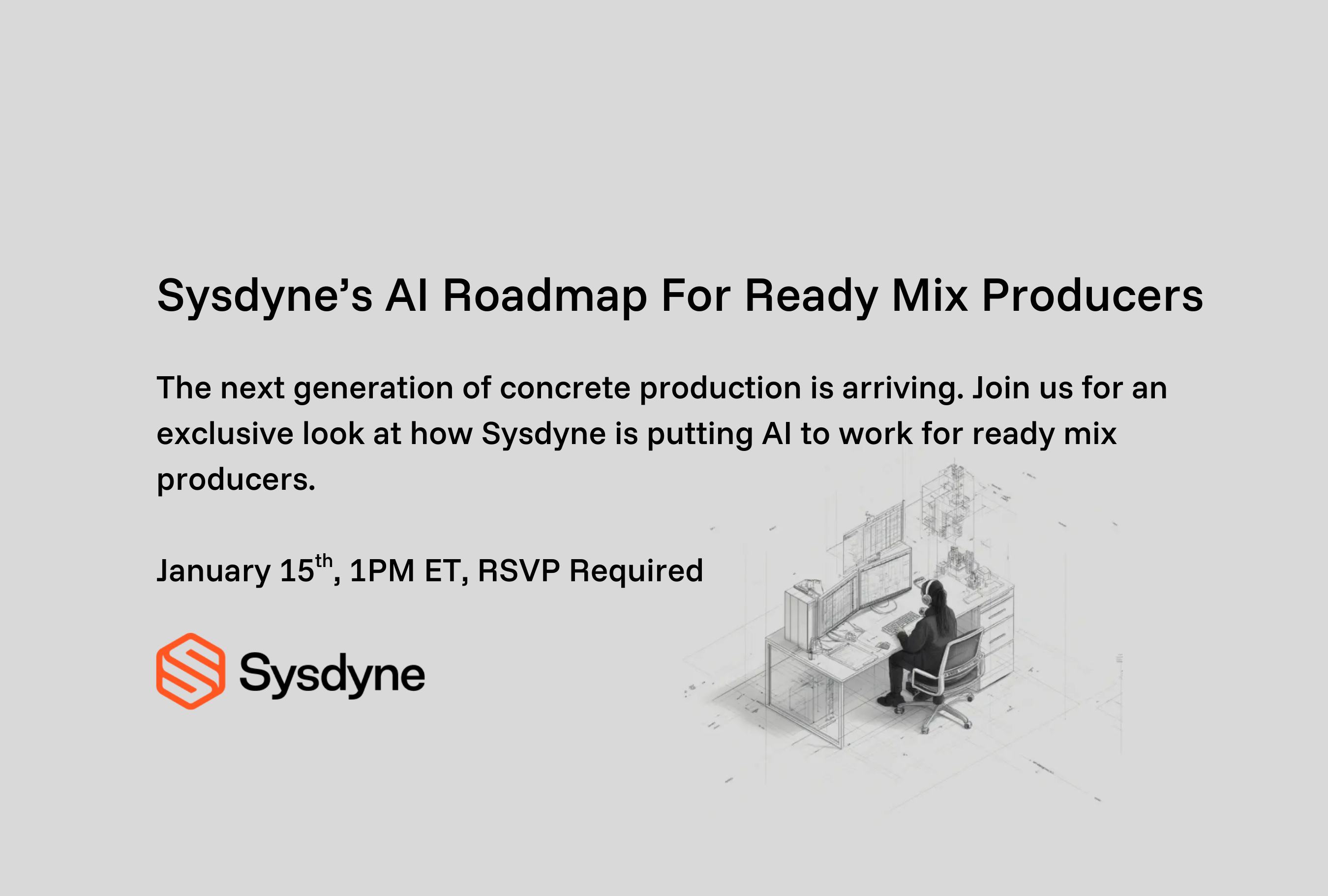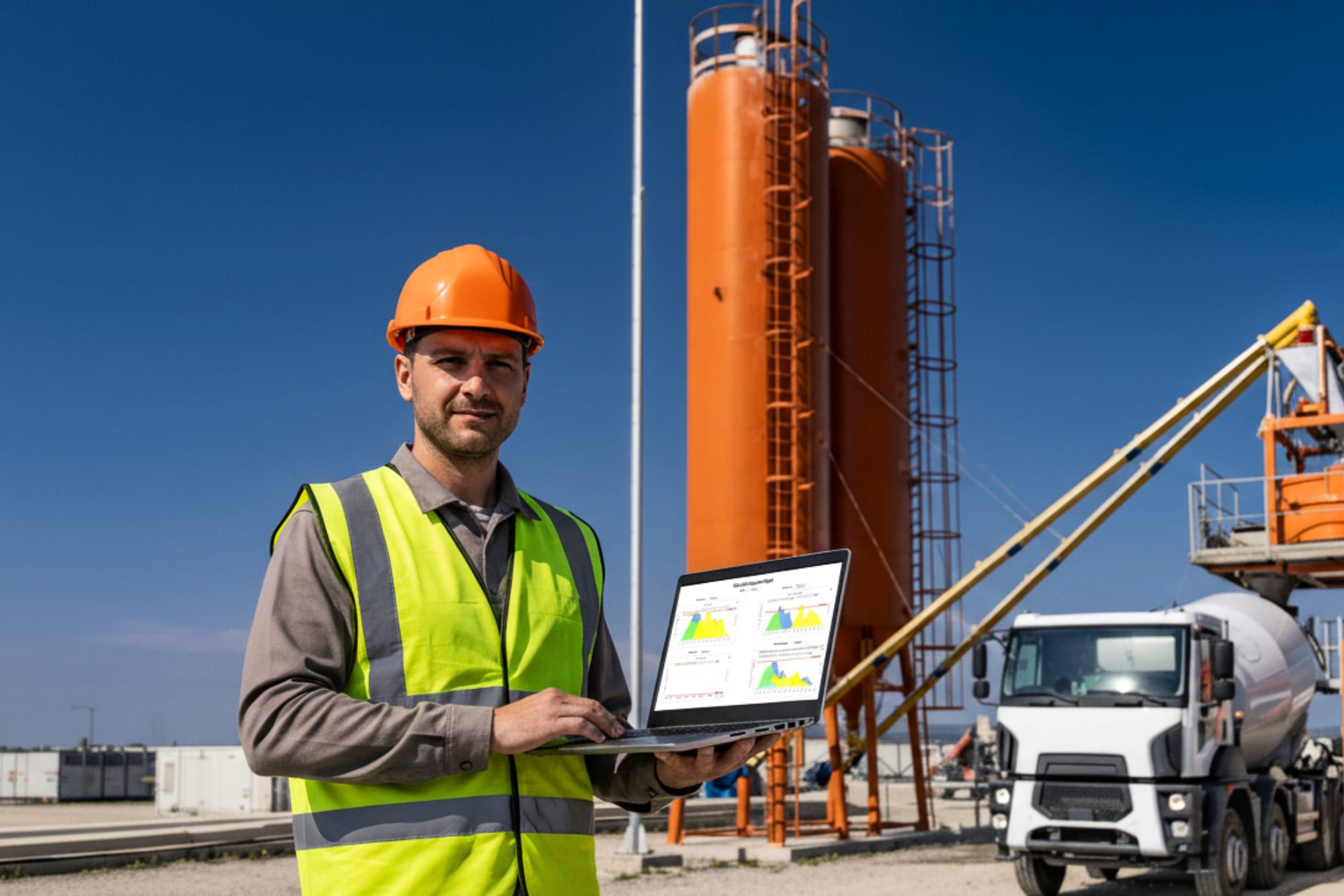
Safety First: How Effective Dispatching Can Improve Safety in Concrete Delivery
Safety First: How Effective Dispatching Can Improve Safety in Concrete Delivery
Safety is the cornerstone of any concrete delivery operation. Given the complexities of transporting heavy materials through urban and rural landscapes, the risks involved in concrete transportation are high. From traffic congestion to adverse weather conditions, numerous variables can endanger drivers and the public. However, effective dispatching can mitigate these risks, improving concrete delivery safety for everyone involved.
Dispatching isn’t just about getting concrete mix trucks from Point A to Point B. It’s about ensuring that deliveries are made safely, on time, and in compliance with safety regulations. By focusing on route planning, monitoring driver behavior, and maintaining real-time communication, concrete delivery companies can reduce accidents and improve safety outcomes. Advanced dispatching systems like Sysdyne’s ConcreteGO play a pivotal role in making this possible, allowing dispatchers to make informed decisions that prioritize safety.
The Role of Dispatching in Managing Concrete Delivery Risks
Dispatching is more than just logistics—it's a critical element in risk management for the ready-mixed concrete industry. Whether it's a busy construction project site or an urban road during rush hour, concrete deliveries face a multitude of risks that require constant attention. Dispatchers are on the front lines, monitoring traffic, weather, and job site conditions to ensure that drivers are always on the safest route.
By integrating real-time GPS tracking with dispatch software, companies can manage risks more effectively. For example, if a traffic jam or road closure occurs, dispatchers can instantly reroute drivers to safer, faster routes. Moreover, staying connected through real-time communication tools ensures that both dispatchers and drivers are prepared for any unforeseen circumstances, such as equipment failure or sudden changes in job site requirements. This constant communication reduces the likelihood of accidents and enhances overall concrete delivery safety.
Real-Time Data for Improved Safety Decisions
Relying on static information to enact and enforce safety measures is no longer sufficient. Real-time data provides a dynamic view of the challenges faced on the road. This is especially important in the concrete delivery industry, where time-sensitive materials must be transported efficiently without compromising safety.
The right dispatching solutions utilize real-time data to empower dispatchers with up-to-the-minute information about traffic patterns, weather conditions, and potential hazards. This allows concrete mix workers to make quick adjustments, guiding drivers away from dangerous areas and toward safer routes. By reducing exposure to risks such as heavy traffic or hazardous weather, companies can significantly lower the chances of accidents during concrete delivery.
Managing Driver Fatigue and Workloads
Fatigue is a well-known hazard in the transportation industry. Overworked drivers are not only at risk of making mistakes but are also more likely to be involved in accidents. To combat this, dispatchers must ensure that drivers are not pushed beyond their limits.
Effective dispatching plays a crucial role in managing driver workloads. By monitoring driver hours and workloads in real-time, dispatchers can ensure that no driver is overworked. Advanced scheduling systems can alert dispatchers when drivers are nearing their limits, enabling them to make changes before fatigue sets in. This improves driver safety and ensures compliance with safety regulations regarding maximum working hours.
Concrete drivers face several health hazards on construction project sites, primarily due to the nature of the environment and materials they work with. Prolonged exposure to cement dust can lead to respiratory issues, such as silicosis, a lung disease caused by inhaling fine silica particles. Drivers are also at risk of skin irritation and chemical burns from direct contact with wet concrete, which contains caustic substances.
Additionally, navigating busy job sites with heavy machinery, uneven terrain, falling objects, and unpredictable weather conditions increases the likelihood of slips, trips, falls, and other physical injuries. Proper safety gear, personal protective equipment, training, and adherence to safety protocols are essential to mitigating these risks on a construction site or on the road.
How Dispatching Reduces Accidents in Mixed Concrete Delivery
One of the key ways dispatching improves safety is by reducing accidents. When routes for concrete trucks are optimized and communication is clear, drivers can focus on the road rather than worrying about making up lost time or navigating through unfamiliar areas. This is particularly important in concrete delivery, where time-sensitive materials must reach the job site promptly.
Optimized Routes and Safe Driving to Every Construction Site
Route optimization is essential for ensuring safe dispatching practices. Dispatchers who use GPS tracking and real-time data can plan the safest and most efficient routes for their concrete truck drivers. This means avoiding areas with high accident rates, heavy traffic, or dangerous road conditions.
Concrete delivery is especially prone to accidents due to the nature of the materials being transported. Heavy, unwieldy trucks must navigate through tight spaces and urban environments, which can make sudden stops, sharp turns, and lane changes more dangerous. By optimizing routes, dispatchers can help drivers avoid these situations, significantly reducing the risk of accidents.
For example, if dispatchers notice a traffic jam ahead, they can reroute drivers to safer roads with fewer hazards. This not only ensures the safety of the drivers but also improves fuel efficiency and reduces wear and tear on the vehicle. In the long term, fewer accidents mean lower insurance premiums and fewer legal issues for concrete companies, making dispatching concrete delivery safety a smart investment.
Communication Tools for Safe Dispatching
Clear communication is key to reducing accidents and persistent or severe discomfort in concrete delivery. Dispatchers need to stay in constant contact with drivers, providing updates on traffic conditions, weather changes, and job site requirements. Many modern dispatch systems, like ConcreteGO, come equipped with advanced communication tools that allow for seamless interaction between dispatchers and drivers.
These tools help prevent accidents by keeping drivers informed of route changes, potential hazards, or new job site instructions. When drivers have the latest information, they can make safer decisions on the road. Additionally, communication tools can be used to monitor driver behavior in real time. If a driver is speeding or showing signs of fatigue, dispatchers can intervene immediately to correct the behavior, improving overall driver safety in concrete transportation.

Effective Dispatching for Fleet Safety in Mixed or Wet Concrete Delivery
Fleet safety is another crucial area where dispatching has a significant impact. Concrete delivery fleets are composed of large, heavy vehicles that require regular maintenance and monitoring to ensure they operate safely. Dispatchers play a key role in managing this aspect of the business, ensuring that vehicles are well-maintained and that drivers follow safe driving practices.
Monitoring Vehicle Health and Performance
Effective fleet management starts with monitoring the health and performance of vehicles. Dispatchers can use advanced fleet management software to track vehicle conditions in real-time. This allows them to schedule maintenance proactively, reducing the risk of mechanical failures that could lead to accidents.
Compliance with Safety Measures and Regulations
Compliance with safety standards is non-negotiable in the concrete delivery industry. Dispatchers must ensure that all drivers and vehicles comply with relevant regulations, including those set by the Department of Transportation (DOT) and Occupational Safety and Health Administration (OSHA).
Dispatchers are responsible for maintaining accurate records of driver hours, vehicle inspections, and safety protocols. By using advanced dispatch software like ConcreteGO, dispatchers can automate much of this process, ensuring that all records are up-to-date and easily accessible. This not only reduces the risk of non-compliance but also streamlines operations, allowing dispatchers to focus on more critical tasks.
Non-compliance can lead to hefty fines and legal issues, not to mention the risk of accidents due to poor safety practices. Dispatchers play a key role in avoiding these problems by ensuring that all drivers and vehicles meet the necessary safety standards.
How Sysdyne Technologies Enhances Concrete Delivery Safety with Advanced Dispatching Solutions
At Sysdyne Technologies, we understand the challenges that concrete producers face when it comes to safety. That’s why we’ve developed ConcreteGO, a cutting-edge dispatching solution that prioritizes safety without compromising efficiency. Our software offers real-time data, route optimization, and fleet monitoring tools that help dispatchers make safety-focused decisions every step of the way.
Sysdyne’s Real-Time Data and Route Optimization Tools
One of the standout features of ConcreteGO is its ability to provide dispatchers with real-time data on traffic patterns, road conditions, and potential hazards. This allows dispatchers to reroute drivers to safer roads, avoiding areas prone to accidents. By making real-time adjustments to delivery routes, dispatchers can ensure that concrete is delivered safely and on time.
Route optimization tools also help reduce fuel consumption and vehicle wear and tear, as drivers can take more efficient routes that avoid unnecessary detours. This proactive approach to safety and efficiency benefits both the company and its drivers, leading to fewer accidents and improved concrete delivery safety best practices.
Sysdyne’s Comprehensive Fleet Monitoring and Driver Management
Fleet safety goes beyond just keeping vehicles in good condition—it’s also about monitoring driver behavior and ensuring compliance with safety regulations. ConcreteGO allows dispatchers to track driver performance in real-time, identifying potential issues such as speeding, harsh braking, or excessive idling.
By using these insights, dispatchers can provide feedback to drivers, helping them improve their driving habits and avoid unsafe behaviors. Additionally, ConcreteGO includes tools for managing driver workloads and schedules, ensuring that no driver is overworked or fatigued. This comprehensive approach to safe concrete fleet management reduces the risk of accidents and ensures that every delivery is made as safely as possible.
Proper Dispatching Helps Protect Drivers Concrete and Construction Industry
In the concrete delivery industry, safety must always come first. By implementing effective dispatching practices, companies can reduce accidents, optimize routes, enhance driver safety, and enable drivers to complete their jobs with peace . Tools like Sysdyne’s ConcreteGO make it easier for dispatchers to manage the complexities of concrete delivery while prioritizing safety at every turn.
With real-time data, route optimization, and fleet monitoring, ConcreteGO empowers dispatchers to make informed decisions that protect both drivers and the public. When safety is the priority, everyone wins.
Make safety a priority today with Sysdyne’s dispatching solutions, and see how you can transform your operations into a safer, more efficient process. Get in touch with us.


